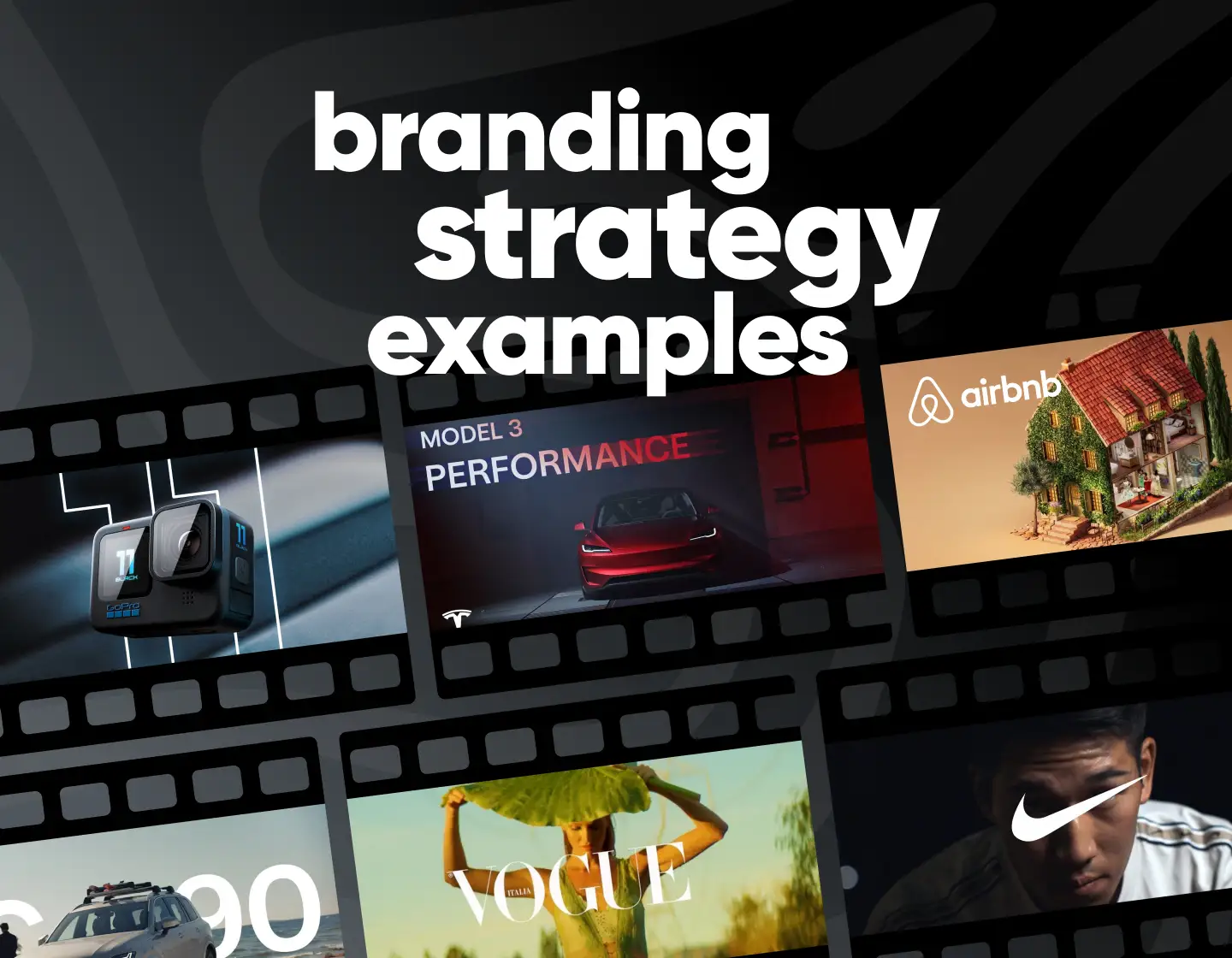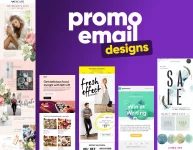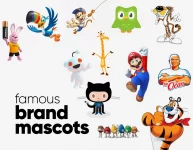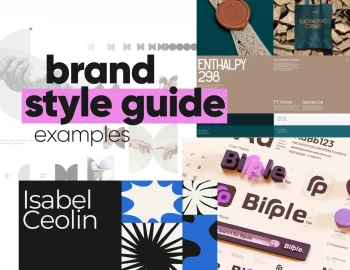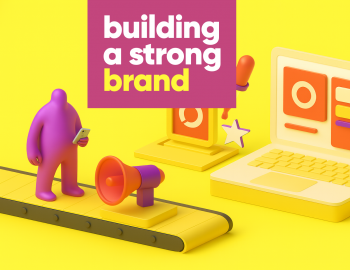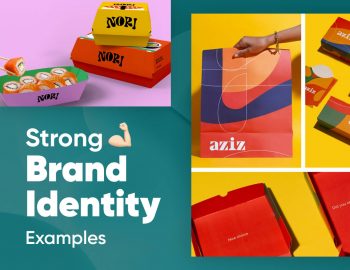Have you ever thought, “Wow, this company is so successful, what’s their secret?” Because I know I have! I think we can all agree that a huge part of their success lies in a strong brand identity.
In today’s competitive world, staying ahead when it comes to building memorable, impactful brands is more important than ever. That’s why, in this article, I’m sharing with you 28 branding strategies from companies that have truly nailed it. These examples will not only inspire you but also help build deeper, more meaningful connections with audiences. Let’s dive in!
✨ Visual Branding: Instantly Recognizable Brands
When it comes to branding, the look is everything. A strong visual identity makes a brand stand out and stick in people’s minds. Whether it’s a logo, color palette, or design style, these visual elements are often the first thing I and other people notice. Let’s take a look at some brands that really got their visual identity on point!
🎨 Color Psychology: Creating an Emotional Impact
Colors help make a brand look good, but they also create a feeling. I’ve always noticed how certain colors instantly make me think of specific brands or moods. Whether it’s the excitement of red, the trust of blue, or the luxury of gold, brands use color to tell a story before you even read a single word.
1. Coca-Cola – The Power of Simplicity
Coca-Cola’s branding is an absolute classic, and honestly, it’s hard for me to imagine a world without that memorable red-and-white color scheme.
One campaign that stood out for me was the “Share a Coke” one. They replaced their iconic logo with popular names on the bottles and I love how this made the bottles personal and unique, like you were sharing something special.
Fun fact: Did you know Coca-Cola played a big role in shaping the Santa we know today? Back in the 1930s, their holiday ads helped turn him into the jolly, red-suited guy we all picture now!
Why This Branding Strategy Works:
- Positioning: Coca-Cola isn’t just selling a drink; it’s selling a feeling of joy and togetherness.
- Storytelling: The red and white color scheme has remained almost unchanged, creating a strong, familiar identity.
- Audience Engagement: Campaigns like the “Share a Coke” one make the brand feel personal and connected to everyday moments.
2. Tiffany & Co. – Blue for Luxury and Exclusivity
Tiffany & Co. knows how to make a color unforgettable with their iconic Tiffany Blue. For me, this shade immediately screams luxury, elegance, and exclusivity. This clever use of color not only makes Tiffany’s products stand out but also reinforces the brand’s image as the go-to for timeless gifts.
Why This Branding Strategy Works:
- Positioning: Tiffany & Co. is all about luxury, exclusivity, and timeless elegance, and Tiffany Blue reinforces that effortlessly.
- Storytelling: The signature blue dates back to 1845, making it a part of the brand’s long-standing legacy of sophistication.
- Audience Engagement: Tiffany Blue is so iconic that even modern collaborations and rebrands keep it at the core of their identity.
👌🏾 Logo Design: Instantly Recognizable, No Name Needed
A logo is one of the most powerful branding tools, it’s the face of a brand and often the first thing people remember. Some logos are so iconic that you don’t even need to see the brand name to recognize them. Think about Nike’s swoosh or Starbucks’ siren, you could spot them in an instant, right?
What makes them so powerful? Simplicity, meaning, and a little bit of magic. Let’s take a look at why these two brands got it so right.
3. Starbucks – The Siren That Started It All
Starbucks’ logo is one of those designs that feels iconic without even trying. That green mermaid (technically a siren), has been around since the very beginning, and over time, she’s evolved into a sleek, modern symbol of coffee culture worldwide.
I love how Starbucks kept the heart of their original design. No words, no coffee cup – just the siren, and yet, you instantly recognize the brand. That’s the power of a great logo – it just works.
Why This Branding Strategy Works:
- Positioning: Starbucks sells a whole experience, making it a go-to “third place” between home and work.
- Storytelling: The siren connects to Starbucks’ Seattle roots and maritime history.
- Audience Engagement: Seasonal cups, collaborations, and design tweaks keep things fresh.
4. Nike – Just Do It
Nike’s logo is one of the most iconic symbols in the world, and it’s a prime example of how simplicity can have a huge impact. The swoosh represents movement and achievement, which aligns perfectly with Nike’s mission to inspire athletes worldwide.
Fun fact: Nike actually paid $35 for the original swoosh design, and it has since become a multi-billion-dollar symbol of motivation!
Why This Branding Strategy Works:
- Positioning: Instantly connects to athleticism and performance, resonating with anyone who wants to succeed.
- Storytelling: The swoosh is all about motion, which reflects Nike’s brand values.
- Audience Engagement: The clean, simple design makes it memorable and easily recognizable.
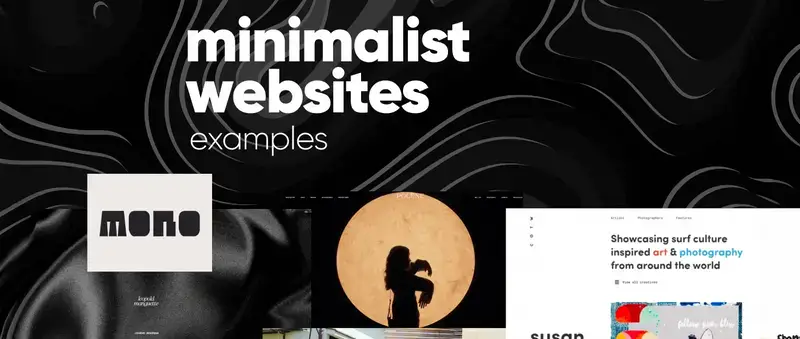
✍️ Typography: Where Fonts Meet Personality
Typography is one of those details that might seem small, but personally, I think it makes a world of difference. The font you choose says so much about a brand’s personality, whether it’s sophisticated, playful, or bold. It’s like the brand’s voice, but in design form. Let’s check out a few brands whose typography really speaks for them.
5. Vogue – The Elegance of Serif Typography
Vogue magazine’s iconic serif font has been the cornerstone of its visual identity for years. Personally, whenever I see their logo, I immediately think of high-end fashion shows, glamorous red carpets, and top-tier style.
What I love about Vogue’s typography is that it feels both timeless and authoritative, which is exactly what such a brand needs to establish its position at the top of the fashion industry.
Why This Branding Strategy Works:
- Positioning: The elegant typography signals luxury and exclusivity, placing Vogue at the top of the fashion world.
- Storytelling: That timeless serif font ties Vogue to its classic heritage.
- Audience Engagement: The bold, iconic typeface draws in a high-end fashion community audience.
6. Harley-Davidson – Bold and Rebellious Typography
Whenever I see Harley-Davidson’s font, I think of open roads, freedom, and the power to break away from the norm. Their typography is as bold and rebellious as the riders it represents.
Fun fact: Harley-Davidson has been around since 1903 (more than 100 years!) and has built a loyal following of passionate riders who swear by their bikes.
Why This Branding Strategy Works:
- Positioning: Bold typography and colors mirror Harley’s rugged and independent spirit.
- Storytelling: The strong typeface paired with orange evokes a sense of freedom.
- Audience Engagement: The visuals connect with Harley riders who embrace a life of adventure and individuality.
🎯 Brand Positioning: Being on Top of a Crowded Market
Brand positioning is all about carving out a unique space in the marketplace and making sure your brand is seen, heard, and understood by the right audience. It’s how a brand communicates what it stands for and why it’s the best choice for its customers. Personally, I love thinking of positioning as the “vibe” a brand gives off – it’s how people perceive you in relation to the competition.
💡 Differentiation: Standing Out from the Crowd
Differentiation is all about making a brand stand out in a crowded market. Whether it’s through unique product features, strong values, or an unforgettable customer experience, the key is to offer something that people instantly recognize and connect with. Some brands do this so well that you can spot their influence a mile away, like Volvo and Apple. Let’s take a closer look at how they set themselves apart.
7. Volvo – Prioritizing Safety and Sustainability
Volvo is known for its focus on safety, and it’s become a core part of the brand’s identity. They were the ones who introduced the three-point seatbelt way back in 1959 (pretty impressive, right?). I think it’s awesome how they’re not just protecting drivers but also looking out for the planet!
Why This Branding Strategy Works:
- Positioning: Volvo is the brand when it comes to safety and sustainability- two things that really matter today.
- Storytelling: With a legacy of innovative safety and a future focused on green tech, Volvo connects with consumers who care about their families and the environment.
- Audience Engagement: Volvo is leading the way with its commitment to eco-friendly tech, planning to go fully electric by 2030.
8. Apple – The Premium, Innovative Experience
Apple has turned differentiation into an art. It’s not just about the products, but the overall experience. Did you know that Apple’s ecosystem (how all their products sync together) is one of the main reasons their customers keep coming back? Personally, I’ve been buying Apple products over the years, exactly for their seamless ecosystem and ease of use.
Why This Branding Strategy Works:
- Positioning: Apple positions itself as a premium brand that’s all about innovation and simplicity.
- Storytelling: Apple’s focus on creating a seamless experience connects with consumers who crave both technology and style.
- Audience Engagement: Apple’s ecosystem and brand loyalty keep their users hooked like they’re part of an exclusive community.
💰 Value-Based Positioning: Quality Without the Hefty Price Tag
Not every brand aims to be luxurious or exclusive – some win over customers by delivering great value for the price. I personally love brands that prove you don’t have to break the bank to get quality products or services. The key here? Affordability without sacrificing trust or experience. Let’s check out a couple of brands that have nailed this approach!
9. IKEA – Affordable Design for Everyday Life
IKEA has completely changed the way we think about furniture. High-quality, stylish pieces at a fraction of the price? Yes, please! How exactly? Flat-pack furniture and self-assembly, cutting down on costs while still delivering modern, functional designs.
Why This Branding Strategy Works:
- Positioning: Affordable, stylish, and functional furniture for the everyday consumer.
- Storytelling: IKEA’s philosophy ensures everyone can have a beautiful home, no matter their budget.
- Audience Engagement: Their in-store experience, room setups, and sustainability initiatives keep customers coming back.
10. Aldi – Quality Groceries at Affordable Prices
Aldi proves that you don’t need flashy packaging or big-name brands to get high-quality groceries affordably. They offer fresh food, pantry staples, and even some fun surprise finds – at prices that make people’s wallets happy. Their secret? Private-label products, efficient store layouts, and a no-frills approach that cuts costs without sacrificing quality.
Why This Branding Strategy Works:
- Positioning: Affordable, high-quality groceries without unnecessary markup.
- Storytelling: Focuses on simplicity and savings, for easy and budget-friendly everyday shopping.
- Audience Engagement: Private-label brands, weekly “Aldi Finds” specials and sustainability keep shoppers coming back.
✨ Luxury & Exclusivity: The Power of Prestige
Some brands don’t just sell products, they sell a lifestyle, a dream, and a little bit of “I’ve made it” energy. Can you think of brands that instantly make you think of success, status, and top-tier quality? I bet a few popped into your mind right away.
Whether it’s the price tag, the craftsmanship, or the story behind the brand, these companies know how to make their products feel truly special. Let’s take a look at some brands that have mastered the art of luxury positioning.
11. Tesla – The Future of Luxury Electric Driving
Tesla isn’t just a car company, it’s a status symbol. With sleek designs and cutting-edge technology, The brand has positioned itself as the car of the future. Plus, with features like self-driving capabilities and a massive touchscreen dashboard, driving a Tesla feels more like stepping into a sci-fi movie than a regular commute.
Why This Branding Strategy Works:
- Positioning: Tesla blends luxury with technology, offering a premium experience with great performance.
- Storytelling: The brand is about revolutionizing transportation and leading the future of sustainable energy.
- Audience Engagement: Limited availability, direct-to-consumer sales, and over-the-air software updates create a sense of exclusivity and constant innovation.
12. Rolex – Timeless Luxury and Precision
When I think of luxury watches, Rolex is always the first brand that pops into my mind. With its reputation for creating timepieces that stand the test of time, Rolex is a symbol of success and precision.
Why This Branding Strategy Works:
- Positioning: A luxury symbol that represents success, exclusivity, and craftsmanship.
- Storytelling: Focuses on its Swiss heritage and unmatched quality.
- Audience Engagement: Limited availability and strong brand loyalty make it a status symbol.
📖 Brand Storytelling: Crafting Narratives that Resonate
For me, the best brand stories aren’t just about selling products, they’re about connecting with people on a deeper level. It’s all about why they do what they do and how that story resonates with their audience. A strong brand story builds loyalty and makes customers feel like they’re part of something bigger.
📹 User-Generated Content: Letting Customers Tell the Story
User-generated content (UGC) is one of the most powerful tools for modern storytelling. By allowing customers to share their experiences, brands can create a more authentic and relatable narrative that resonates deeply with their audience. It gives customers a voice and turns them into brand ambassadors, strengthening the connection with the brand.
13. Lululemon – Empowering Through Community Stories
Lululemon’s brand story is rooted in the idea of celebrating the hustle of everyday fitness enthusiasts. With campaigns like the #TheSweatLife hashtag (which has millions of posts, building a vibrant community around the brand), they encourage customers to share their workout moments, turning their community into the brand’s narrative. I think it’s brilliant how they’ve made fitness feel like something you’re part of, not just something you do.
Why This Branding Strategy Works:
- Positioning: Lululemon empowers people to lead healthier, active lives with style.
- Storytelling: By showcasing real stories from their community, the brand feels personal and genuine.
- Audience Engagement: Lululemon keeps things dynamic by inspiring customers to share their fitness journeys.
14. GoPro – Capturing Adventures, Sharing Stories
GoPro’s entire brand story is built on its users capturing their adventures, from extreme sports to heartwarming family moments, and sharing them with the world.
Fun fact: GoPro’s YouTube channel has over 10 million subscribers, mostly driven by user-generated content!
Why This Branding Strategy Works:
- Positioning: GoPro positions itself as a brand for adventurous, action-seeking individuals.
- Storytelling: The brand lets users share their stories, creating an exciting community.
- Audience Engagement: GoPro constantly encourages users to share their content, keeping the narrative fresh and real.
Narrative Branding: Telling Stories That Matter
I think narrative branding is where the real magic happens. A strong narrative gives your brand a soul, turning it from a name on a shelf into something people can relate to and care about. When done right, a great story makes a brand unforgettable, and I’m all about those memorable ones!
15. TOMS Shoes – Making Every Purchase Meaningful
TOMS Shoes crafted a compelling story around social impact with their “One for One” campaign. For every pair of shoes purchased, they donated a pair to a child in need. This transformed buying shoes into an act of social responsibility, creating an emotional connection with customers.
Fun fact: Since 2006, TOMS has donated over 100 million pairs of shoes to children in need worldwide. Truly amazing!
Why This Branding Strategy Works:
- Positioning: TOMS linked purchases to a cause, positioning themselves as socially responsible.
- Storytelling: They turned buying shoes into a meaningful, impactful act.
- Audience Engagement: Customers felt personally involved in a larger mission.
16. Airbnb – Building Connections Through Stories
Airbnb’s brand story revolves around the idea of belonging. Personally, I love how they’ve built an emotional narrative around travel, focusing on human connections and the unique experiences that come with staying in someone’s home. The “Belong Anywhere” campaign perfectly encapsulates this, inviting people to explore the world while connecting with locals.
Fun fact: Airbnb hosts have welcomed more than 500 million guests since the company was founded.
Why This Branding Strategy Works:
- Positioning: Airbnb positions itself as a brand that fosters personal connections and authentic experiences.
- Storytelling: They focus on the idea of belonging and community, making travel feel more personal.
- Audience Engagement: Airbnb encourages users to share their own stories, for a shared adventure and discovery.
🌐 Digital Branding: Connecting Brands to the Digital World
We all live online now, right? Whether it’s scrolling through Instagram or binge-watching YouTube, digital branding has become the heart of how brands connect with us. I love how brands can show off their uniqueness and connect with people online in a way that’s so much more engaging. Let’s dive into some brands that totally get this digital game.
📱Social Media Branding: Where Brands Get Personal
Social media isn’t just a place to post updates, it’s where brands build relationships with their audience. I think the best brands really shine on social by showing personality and staying true to their voice.
17. Oreo – Keeping It Fun & Relevant
Oreo is a perfect example of how to use social media to stay relevant. Their “Dunk in the Dark” tweet during the 2013 Super Bowl blackout is legendary. Oreo keeps it playful, engaging, and, above all, timely with their content, making them a true social media master.
Fun fact: The “Dunk in the Dark” tweet gained 15,000 retweets in 24 hours. How cool!
Why This Branding Strategy Works:
- Positioning: Oreo is the fun, playful cookie that can make any moment a little sweeter.
- Storytelling: The brand tells relatable, humorous stories that resonate with its audience.
- Audience Engagement: Their social media thrives on real-time engagement, reacting to trends and current events.
18. Wendy’s – Roasting with Personality
Wendy’s became famous for its witty comebacks and playful banter with customers and other brands. Wendy’s Twitter has basically turned into a place for entertainment, and I think that’s part of why people are so loyal to the brand!
Why This Branding Strategy Works:
- Positioning: Wendy’s is the cheeky, bold fast food option that’s not afraid to show personality.
- Storytelling: They build their brand story through humor and real-time reactions.
- Audience Engagement: Wendy’s uses their playful tone to interact with customers and fans, creating a sense of connection.
🎥 Content marketing: Crafting Stories That Stick
Content marketing is not just producing articles or blog posts, it’s about telling stories that captivate and connect. Brands use content to educate, entertain, and inspire, turning their audience into lifelong fans. I’ve noticed that the most successful content marketers make sure their message feels authentic and useful like they’re giving you something of value.
19. Red Bull – Pushing Limits Through Content
Red Bull doesn’t just sell energy drinks; they sell a lifestyle. Their content strategy revolves around extreme sports, adventure, and pushing the limits of what’s possible. From their jaw-dropping stunts to their content-heavy YouTube channel, Red Bull is a master at using content to tell a story about living life to the fullest.
Why This Branding Strategy Works:
- Positioning: Red Bull is the brand that fuels adventure and extreme sports.
- Storytelling: The brand crafts high-energy, adrenaline-pumping stories that resonate with their target audience.
- Audience Engagement: Red Bull’s content invites fans to be part of the adventure, with events, videos, and interactive content.
20. Fitbit – Turning Fitness into a Fun, Social Experience
Fitbit has truly mastered the art of engaging their audience with motivational content. They’ve transformed fitness tracking into a social experience with challenges, success stories, and tips that make staying healthy feel like a community effort.
Fun fact: Did you know Fitbit hosts global challenges where users from around the world can compete with friends, family, and even strangers?
Why This Branding Strategy Works:
- Positioning: Fitbit positions itself as a companion on the user’s health journey, helping with the progress and overall experience.
- Storytelling: Real user stories inspire others by showing relatable, everyday fitness achievements.
- Audience Engagement: Interactive challenges and social media integration keep users connected and motivated.
🛜 Digital-First Branding: Born for the Internet
Digital-first branding puts the internet at the core of your brand. These brands were born online, and honestly, I think they’ve really mastered building their identity around the digital world. They don’t just exist on the web—they thrive there, connecting with audiences in ways traditional brands can’t quite match.
21. Netflix – From DVDs to Digital-First Entertainment Giant
Netflix started as a DVD rental service, but its shift to streaming was a game-changer. By prioritizing on-demand access, it changed how we watch TV. I love how they made binge-watching the norm, and let’s be honest, who hasn’t spent an entire weekend wrapped up in a Netflix series?
Fun fact: Netflix spends over $17 billion annually on original content!
Why This Branding Strategy Works:
- Positioning: From DVDs to streaming, Netflix became the go-to for on-demand content.
- Storytelling: Original shows and diverse genres appeal to everyone.
- Audience Engagement: Personalized recommendations make it feel like Netflix knows you.
🤖 AI-Driven Personalization: Tailoring the Experience
Personalization has become a game-changer in branding, especially with AI. Brands now use AI to give customers a unique, tailored experience, making everything feel more personal. I’ve seen how brands are using AI to predict what you’ll love based on your behavior, and it’s honestly pretty cool. Let’s take Spotify for example.
22. Spotify – Personalized Music Experience
Spotify has totally nailed the AI-driven personalization game. With features like “Discover Weekly” and “Release Radar,” they use AI to give users a highly personalized music experience. I’m always amazed by how well the app knows my music taste.
Why This Branding Strategy Works:
- Positioning: Spotify creates a unique, personal experience for every listener
- Storytelling: Personalized playlists make users feel like they’re on a journey with their favorite songs, discovering new ones along the way.
- Audience Engagement: The more Spotify personalizes, the more users interact, ensuring they’re hooked for hours.
23. Sephora – Personalized Shopping Experience with AI
I love how Sephora uses AI to give personalized makeup recommendations, especially with their Sephora Virtual Artist. You can try on products virtually to see how they’ll look on you.
Fun fact: Their app even suggests makeup based on your face shape, skin tone, and preferences, for a unique shopping experience.
Why This Branding Strategy Works:
- Positioning: Reinvents beauty shopping with tech and personalization.
- Storytelling: Uses AI to make shopping more engaging and personal.
- Audience Engagement: Allows customers to try before they buy, increasing satisfaction and sales.
🌍 Global Branding: Creating a Brand That Speaks Worldwide
I think you can agree that building a brand that’s recognizable and loved across the globe is no easy feat. But the best global brands know how to keep their core values intact while tweaking their message to resonate in different countries. I find it so fascinating how these brands manage to connect with people, no matter where they are in the world.
Adaptation vs. Standardization: Finding the Right Balance
When brands go global, they face a big question: Should they adapt to local markets or keep things consistent everywhere?
Adaptation means tweaking products, marketing, or even how things are sold to match local preferences. Think about how McDonald’s switches up its menu depending on the country, offering different foods in India compared to those in Japan.
Standardization, on the other hand, is all about keeping things the same everywhere. For example, brands like Google maintain a consistent interface, design, and user experience worldwide.
Most successful global brands don’t pick just one, they find a balance. They keep their core brand identity intact while making smart local adjustments. Let’s check out two examples of global branding.
24. Google – A Global Giant with a Local Touch
Google is the definition of a standardized global brand. I love that it’s become so much more than a search engine. It’s a global tech powerhouse that adapts to local cultures, languages, and needs, making sure it stays relevant everywhere. Chances are, you’ve Googled something today, right?
Fun fact: Did you know that Google’s name comes from the word “googol,” which refers to the number 1 followed by 100 zeros?
Why This Branding Strategy Works:
- Positioning: Google is positioned as the go-to platform for information, connecting people to the world’s knowledge instantly.
- Localization: Google adapts its products and services to fit local languages, cultures, and needs (like region-specific search results).
- Innovation: Google is always evolving and introducing new products and services, keeping it at the forefront of the tech world.
25. McDonald’s – Big Mac With a Local Twist
McDonald’s is one of the best examples of balancing standardization and adaptation and is the ultimate example of a brand that feels familiar, no matter where you are in the world. Walk into a McDonald’s in Tokyo, Paris, or New York, and you’ll instantly recognize the golden arches, but the menu? That’s where things get interesting! From the McAloo Burger in India to the Teriyaki Burger in Japan, McDonald’s masterfully blends global consistency with local flavors.
Fun fact: McDonald’s serves over 69 million people every day across more than 100 countries!
Why This Branding Strategy Works:
- Positioning: A fast, affordable, and family-friendly dining option, no matter where you are.
- Localization: Adjusting the menu to fit local tastes while keeping fan-favorite classics like the Big Mac.
- Consistency: The golden arches, red and yellow branding, and friendly service make it instantly recognizable worldwide.
🔄 Brand Evolution & Adaptation: Evolving with the Times
Brand evolution is essential for staying relevant in today’s fast-paced market. Whether it’s through rebranding to shed an old image or adapting to major changes in consumer behavior, brands must be flexible to succeed.
📌 Rebranding: A Fresh Start for Iconic Brands
Rebranding is a big change for any company. It’s a shift in how the brand connects with people, either to stay current, attract a new audience, or evolve with the market. The right rebrand can make a huge difference and open doors to new opportunities. Let’s dive into how some brands nailed this transition!
26. Old Spice – Reinventing Masculinity
Old Spice completely rebranded itself by swapping out its old-school image for a playful, modern one. With their iconic “Old Spice Guy” campaign, they attracted a younger audience by adding humor and energy to their brand.
Why This Branding Strategy Works:
- Positioning: Transformed from classic to playful and modern.
- Storytelling: Used humor to create memorable, viral ads.
- Audience Engagement: Connected with a younger, digitally savvy audience.
27. Burberry – A Fresh Take on British Heritage
Burberry embraced its British roots while making moves to appeal to a younger crowd. By collaborating with young designers and diving into digital trends, they managed to combine luxury with street style.
Fun fact: Burberry was one of the first luxury brands to live-stream its runway shows.
Why This Branding Strategy Works:
- Positioning: Balanced tradition with modern style.
- Storytelling: Reinvented British luxury for a new generation.
- Audience Engagement: Leveraged digital platforms and influencer partnerships.
✔️ Adapting to Market Changes: Staying Ahead of the Curve
Adapting to market changes means brands adjust to keep up with what people want, trends, and new tech. They switch things up by creating new products, changing their messaging, or exploring different ways to sell. I think this kind of flexibility is key to staying relevant, especially with how fast everything evolves these days.
28. Amazon – Continuously Evolving to Lead the Market
Amazon started as a bookstore and now leads in e-commerce, tech, and entertainment. By constantly adapting and expanding, they’ve become the go-to platform for nearly everything. Their willingness to evolve has helped them stay ahead of the curve. I personally admire how they always seem to be one step ahead in creating new services and experiences for their customers.
Why This Branding Strategy Works:
- Positioning: From books to everything, Amazon positioned itself as the ultimate one-stop shop.
- Storytelling: The “Earth’s Most Customer-Centric Company” story keeps customers engaged.
- Audience Engagement: Personalized recommendations and Prime loyalty keep users coming back.
Final Words
In the end, great branding leaves a lasting impression that goes far beyond what you see at first glance. Brands that push boundaries by reinventing their products, sales tactics, and tech are the ones that thrive. I believe that when brands get real, personal, and compassionate, adjusting their approach as markets change, they build genuine connections with their audience.
The future of branding belongs to those willing to take risks, evolve with the times, and stay true to their core values. When a brand puts in the work to stay relevant and connect with its audience, it’s amazing to watch how they grow.
Here are some more articles you may like:


